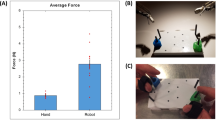Abstract
This study explored haptic feedback methods that do not rely on tangential forces, aiming to address the miniaturization challenges of haptic feedback devices in current virtual reality environments. We employed a six-degree-of-freedom haptic interface to construct a virtual grasping scene that simulates the stick-slip phenomenon. By comparing user grip response speed and force adjustment capability under different conditions: no haptic feedback, vibration feedback, and vibration with tangential force feedback, we collected data on users’ grip responses under different haptic conditions. The results demonstrate that vibration feedback can significantly improve users’ grip response speed without tangential forces. However, without tangential forces, users find it hard to differentiate responses based on the weight of objects. This indicates that while vibration feedback can simplify the design of haptic devices and enhance response speed, tangential forces are still essential for accurate weight perception. The theoretical and practical significance of this research lies in providing a new direction for haptic feedback devices in virtual reality.
Access this chapter
Tax calculation will be finalised at checkout
Purchases are for personal use only
Similar content being viewed by others
Notes
References
Balandra, A., Gruppelaar, V., Mitake, H., Hasegawa, S.: Enabling two finger virtual grasping on a single grasp 6-DOF interface, by using just one force sensor. In: 2017 IEEE World Haptics Conference, pp. 382–387. IEEE (2017)
Cavanagh, P.R., Komi, P.V.: Electromechanical delay in human skeletal muscle under concentric and eccentric contractions. Eur. J. Appl. Physiol. 42, 159–163 (1979)
Cole, K.J., Abbs, J.H.: Grip force adjustments evoked by load force perturbations of a grasped object. J. Neurophysiol. 60(4), 1513–1522 (1988)
Flanagan, J.R., Tresilian, J.R.: Grip-load force coupling: a general control strategy for transporting objects. J. Exp. Psychol. Hum. Percept. Perform. 20(5), 944 (1994)
Han, L., Trinkle, J.C.: Dextrous manipulation by rolling and finger gaiting. In: Proceedings of the 1998 IEEE International Conference on Robotics and Automation, vol. 1, pp. 730–735. IEEE (1998)
Johansson, R.S., Flanagan, J.R.: Coding and use of tactile signals from the fingertips in object manipulation tasks. Nat. Rev. Neurosci. 10(5), 345–359 (2009)
King, C.H., et al.: Tactile feedback induces reduced grasping force in robot-assisted surgery. IEEE Trans. Haptics 2(2), 103–110 (2009)
Konyo, M., Yamada, H., Okamoto, S., Tadokoro, S.: Alternative display of friction represented by tactile stimulation without tangential force. In: Ferre, M. (ed.) EuroHaptics 2008. LNCS, vol. 5024, pp. 619–629. Springer, Heidelberg (2008). https://doi.org/10.1007/978-3-540-69057-3_79
Li, K., Brown, J.D.: Dual-modality haptic feedback improves dexterous task execution with virtual EMG-controlled gripper. IEEE Trans. Haptics 16(4), 816–825 (2023)
Masataka, N., Konyo, M., Maeno, T., Tadokoro, S.: Reflective grasp force control of humans induced by distributed vibration stimuli on finger skin with ICPF actuators. In: Proceedings of the 2006 IEEE International Conference on Robotics and Automation, pp. 3899–3904. IEEE (2006)
Okamoto, S., Wiertlewski, M., Hayward, V.: Anticipatory vibrotactile cueing facilitates grip force adjustment during perturbative loading. IEEE Trans. Haptics 9(2), 233–242 (2016)
Quek, Z.F., Schorr, S.B., Nisky, I., Provancher, W.R., Okamura, A.M.: Sensory substitution and augmentation using 3-degree-of-freedom skin deformation feedback. IEEE Trans. Haptics 8(2), 209–221 (2015)
Walker, J.M., Blank, A.A., Shewokis, P.A., O’Malley, M.K.: Tactile feedback of object slip improves performance in a grasp and hold task. In: 2014 IEEE Haptics Symposium, pp. 461–466. IEEE (2014)
Wiertlewski, M., Endo, S., Wing, A.M., Hayward, V.: Slip-induced vibration influences the grip reflex: a pilot study. In: 2013 World Haptics Conference, pp. 627–632. IEEE (2013)
Xu, Y., Wang, S., Hasegawa, S.: Realistic dexterous manipulation of virtual objects with physics-based haptic rendering. In: ACM SIGGRAPH 2023 Emerging Technologies, pp. 1–2 (2023)
Zangrandi, A., D’Alonzo, M., Cipriani, C., Di Pino, G.: Neurophysiology of slip sensation and grip reaction: insights for hand prosthesis control of slippage. J. Neurophysiol. 126(2), 477–492 (2021)
Acknowledgments
This work was supported by JST, the establishment of university fellowships towards the creation of science technology innovation, Grant Number JPMJFS2112, and JSPS KAKENHI Grant Number 23H03432.
Author information
Authors and Affiliations
Corresponding author
Editor information
Editors and Affiliations
Rights and permissions
Copyright information
© 2025 The Author(s), under exclusive license to Springer Nature Switzerland AG
About this paper
Cite this paper
Xu, Y., Wang, S., Hasegawa, S. (2025). Optimizing Haptic Feedback in Virtual Reality: The Role of Vibration and Tangential Forces in Enhancing Grasp Response and Weight Perception. In: Kajimoto, H., et al. Haptics: Understanding Touch; Technology and Systems; Applications and Interaction. EuroHaptics 2024. Lecture Notes in Computer Science, vol 14768. Springer, Cham. https://doi.org/10.1007/978-3-031-70058-3_3
Download citation
DOI: https://doi.org/10.1007/978-3-031-70058-3_3
Published:
Publisher Name: Springer, Cham
Print ISBN: 978-3-031-70057-6
Online ISBN: 978-3-031-70058-3
eBook Packages: Computer ScienceComputer Science (R0)




